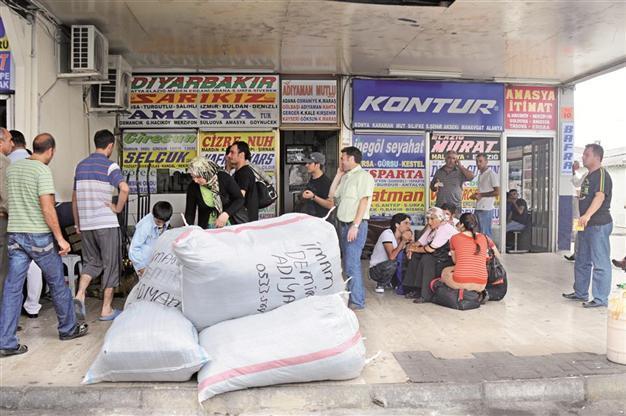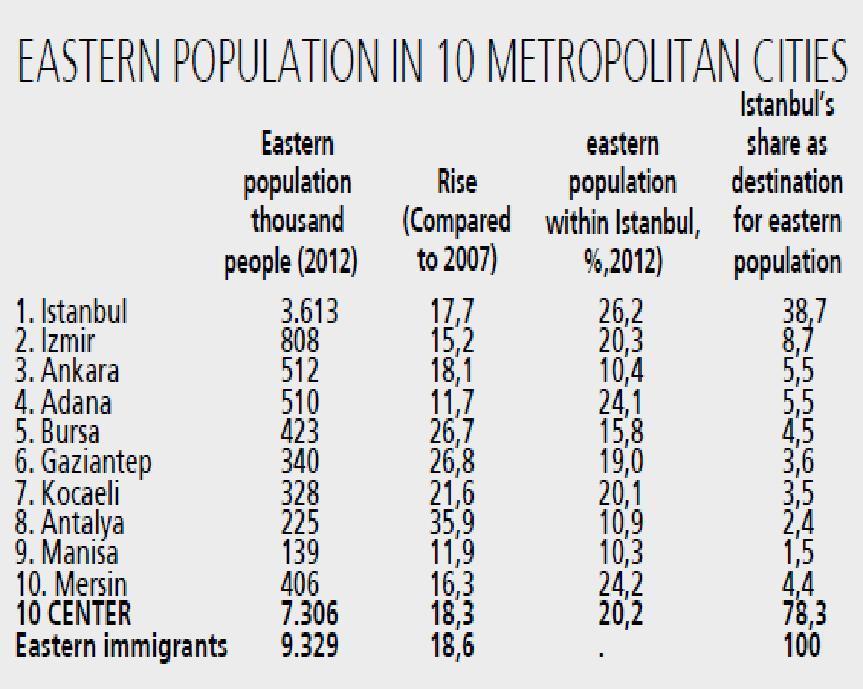Kurds still migrating to western Turkish cities
Mustafa SÖNMEZ ISTANBUL - Hürriyet Daily News

The rate of eastern and southeastern population living outside its hometown has increased to 47 percent in 2012 from 44 percent in six years, TÜİK data shows.
Turkey is a country of migration. Especially after the 1950s, migration waves began from rural to urban areas such as Istanbul and have continued without ceasing for 60 years. And it is not likely to end, either. Today, migration is still ongoing mostly from the Black Sea, the eastern, southeastern and Central Anatolian regions to western and Mediterranean provinces.
The aspects of migration are striking, especially in the eastern and southeastern regions, which are the least developed regions in Turkey. One of the things that is currently drawing interest is this: Are the migrations from the eastern and southeastern regions still ongoing? Why are people wondering about that? First of all, has the population of the region, mostly composed of Kurdish people, given up on the idea of migrating for security reasons when Turk-Kurd polarization has reached its peak? Especially in Southeast Anatolia, where Kurds are densely populated, will scenarios such as “autonomous administrations” or “a federal structure” deter the population from migrating?

Since 2007, data on population movements are updated each year with an address-based population registration system. According to this data, the place where one resides and the place of registry is divided. For example, let’s say you are registered in Van province but you are living in Istanbul. According to this data, you could count how many people are registered in Van and how many of them reside in Van or other provinces. This provides information on the “cumulative migration of a population.”
So, between 2007 and 2012, is there a change in the distribution of the population registered in the 21 eastern and southeastern regions, where Kurds mostly live?
It is seen that between 2007 and 2012, the number of those born and registered in these 21 provinces increased from 18 million to 20 million. So, over the last six years, the number of citizens from these cities has increased by 11 percent, or 2 million. The increase in other regions over the same period is 5.5 percent.
Also, it is known that fertility rates are higher in eastern and southeastern regions.
The second result is, at the end of 2007, 44 percent of those registered in these 21 provinces were not residing in the place they were born. At the end of 2012, we see that this rate had reached 47 percent.
Who migrates more? The main reason for migration is clear. To make a living, to have a job and the like… So, aren’t there any other factors? Of course there are. Getting away from an area of hardship and feuds, trying to escape threats to safety and property, as well as threats from natural disasters, seeking better conditions and finding expanded business opportunities for investors are all among the reasons. The northeastern provinces tend to migrate more. Some 81 percent of those registered in Ardahan, 76 percent of Tunceli, 73 percent of Erzincan and 66 percent of Kars live away outside their hometowns.
When looking at the southeastern provinces, among those born in Siirt, where Arab citizens are also densely populated, about 61 percent live outside of Siirt. Among those from Mardin, which has almost the same characteristics as Siirt, more than 51 percent have migrated to other places. Also, nearly one-third of people registered in Diyarbakır, which has a population of 2 million, are residing outside of the province. The same goes for Şanlıurfa. Van has also experienced a lot of migration with the effect of the 2011 earthquakes, and currently about 30 percent of those born in Van live outside of the province. This rate was only 25 percent in 2007.
Istanbul, Istanbul…Over the last five years, 2 million people registered in these 21 provinces migrated to western provinces. So, the number of migrants coming from eastern provinces reached 9.3 million. The migration of many Kurdish people to western cities despite all the risks of ethnic polarization and provocations can also be read as a “message of willingness to live together.” Despite the negative atmosphere, many poor citizens in eastern provinces keep migrating to developed provinces such as Istanbul to pursue their desires, find a job and meet other expectations. The main choice of these 9 million migrants is Istanbul, of course. We see that the number of people coming from the east to Istanbul reached 3.6 million in 2012, which means an 18 percent increase when compared with 2007. So, former president Süleyman Demirel was right when he said “Istanbul is the biggest Kurdish city.”
As can be seen from data, at least 100,000 people from the east migrate to Istanbul each year. Some 38 percent of those from the east living away from their hometowns are in Istanbul. Mostly composed of Kurds, those from Malatya are first at 11 percent, while Erzincan follows at 8 percent; Van, Diyarbakır, Batman, Şanlıurfa, Bitlis and Siirt each account for about 5 percent of the eastern population of Istanbul. Ten provinces host about 80 percent of the eastern migrants, while half of them are residing in Istanbul.

A decrease in migration is not expected in the near future. The regime of neoliberal accumulation will continue as far as it can by constructing new buildings on the basis of foreign debt and sustaining Istanbul-focused growth, and it never takes a break and searches for a “balance in space.” This means that the migration from the east will continue, which is also true for every region in Turkey.
Of course, the migration of the poor is not a delightful thing, but despite all the hostilities and threats from assailants who call themselves Turkish nationalists, demanding rights in Istanbul and İzmir, trying to make a living in such regions and putting claims on these developed areas is important and encouraging.
Cities Kurds migrate more
Following Istanbul as “the biggest Kurdish city,” İzmir unsurprisingly receives the second most migrants from eastern Turkey. About 9 percent of eastern migrants reside in İzmir, and the Aegean province’s eastern population has increased by 15 percent since 2007, meaning that easterners now account for more than one-fifth of İzmir’s overall population. Also, another Aegean province Manisa, Bursa and Kocaeli are other industrial provinces where Kurds are densely populated.
The Çukurova is a more traditional destination for eastern migrants.
Also, the Mediterranean province of Antalya has become another center of attraction in recent years thanks to its job opportunities in the agricultural, construction and tourism sectors. Within the last five years, the eastern population in Antalya has increased by 36 percent, a rate which surpasses all other areas in Turkey.


